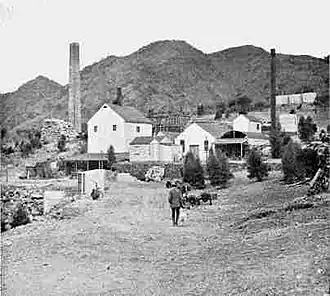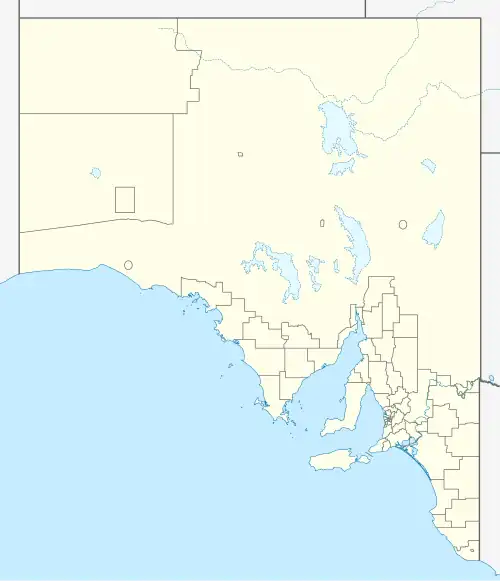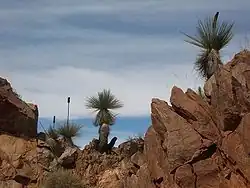Yudnamutana, South Australia
| Yudnamutana South Australia | |
|---|---|
 Copper smelters of Yudnamutana in 1910 | |
 Yudnamutana | |
| Coordinates | 30°10′0″S 139°17′0″E / 30.16667°S 139.28333°E |
| Established | 1862-1865 and 1903-1912 or 1930s?[a] |
| Location | |

Yudnamutana (/jədnəˌmuːˈtɑːnə/ yəd-nə-moo-TAH-nə), also referred to as Yuda, is a historic mining valley in the northern Flinders Ranges of South Australia. Copper was mined there between 1862 and 1865 and again from 1903 to 1912, but has been abandoned since. It is located at Mount Freeling, northwest of Arkaroola on the edge of the wilderness sanctuary.
History
Indigenous people
This area was inhabited by the Adnyamathanha people of Aboriginal Australians for millennia (up to 49,000 years) before the arrival of Europeans.[1][2][3]
European settlement
This area was first settled by pastoralists in the 1950s.[4] Mount Freeling pastoral lease was established 1870.[5]
Prospectors followed soon afterwards, hoping to find another copper deposit similar to that found at Burra.[4]
Mining
In 1859 a copper deposit was found by A. Frost and H. Gleeson.[4][6] Yudnamutana was the site of an early South Australian copper mine, which also became known as Yuda.[7] First mined in 1862, it reached fame in Adelaide shortly afterwards when a block of ore weighing 4 tonnes (3.9 long tons) was paraded through the streets. Copper concentrates were hauled to Port Augusta in drays by animals along rough tracks – a distance of about 300 kilometres (190 miles). This limiting factor affected the company's profitability. A drought in 1869 forced the closure of the mine[b] because not enough water was available for animals that worked at the mine. 1862-1865 and 1903-1912[8][9]
Another attempt was made at mining the site at the start of the 20th century. Transport was less costly this time – by dray for only 100 kilometres (62 miles) to the Central Australia Railway at Farina, then by train. The mine's proprietors tried to further reduce the cost of transport by instigating a road train to Farina railway station in 1909. However, the rough terrain and mechanical breakdowns soon ended the scheme.[4]
A small smelter was constructed at Farina in 1909 or 1910, but it closed after only a few experiments, and was demolished in 1938.[10]
One source reports that the mine itself finally closed by 1912;[9] another says that it was worked by Flinders Copper Mining Company between 1914 and 1918;[7] a third says that it was worked sporadically up until the 1930s.[11]
All that remains of this settlement are two large boilers, some mine shafts, some dugouts and the cemetery.[9]
Location and description
The valley is located at Mount Freeling, to the northwest of Arkaroola Wilderness Sanctuary. It is situated on the divide between the basins of Lake Eyre, Lake Frome, and Lake Blanche.[4]
The site is accessible by four-wheel drive from the south.[5] A hike on Mawson Plateau that takes 7-10 days, starting via Mount Freeling Station, passing the Mount Fitton Station ruin and the mine site, is described on the Adelaide Bushwalkers website.[12]
The northern pass hosts black rocks of magnetite. Other minerals at Yuda include azurite, malachite, quartz, and others.[7]
Footnotes
- ^ Dates vary in the sources - see article body.
- ^ Mindat.org says 1867 closure.[7]
References
- ^ "LibGuides: Aboriginal people of South Australia: Adnyamathanha". LibGuides at State Library of South Australia. 5 February 2025. Retrieved 16 August 2025.
- ^ Rimmer, Michelle (4 November 2016). "Historic discovery places Adnyamathanha people in outback Australia 10,000 years earlier than thought". NITV. Retrieved 16 August 2025.
- ^ Fuge, Lauren (31 July 2025). "Friday essay: 'You can do graffiti … by breathing' – I visited Adnyamathanha rock art as old as the Lascaux cave paintings". The Conversation. Retrieved 16 August 2025.
- ^ a b c d e "A Brief History Of The Yudnamutana Mining Field, South Australia". Archived from the original on 30 September 2007.
Republished with permission from Mineralogical News, the Journal of the Mineralogical Society of South Australia
- ^ a b "Mount Freeling Track, from Lyndhurst to Arkaroola". 4X4 Australia. 10 February 2025. Retrieved 15 August 2025.
- ^ Record of the mines of South Australia Internet Archive, Canadian Libraries
- ^ a b c d "Yudnamutana Mine, Yudnamutana District, Arkaroola (Arkaroola Wilderness Sanctuary; Arkaroola Station), Pastoral Unincorporated Area, South Australia, Australia". Mindat.org. 16 August 2025. Retrieved 16 August 2025.
- ^ Sprigg, R.C., 1984: Arkaroola-Mount Painter in the Northern Flinders Ranges, S.A: The Last Billion Years. Lutheran Publishing House, Adelaide
- ^ a b c The Flinders Ranges – Glovebox Guide, Australian Geographic, 2000, p. 147, ISBN 1-86276-044-6
- ^ Donovan & Associates/Austral Archaeology (1995). Flinders Ranges Heritage Survey. Adelaide: Department of Environment and Natural Resources South Australia. p. 1‑27.
- ^ "Copper". Flinders Ranges History. 29 September 1920. Retrieved 16 August 2025.
- ^ May, Trevor (7 July 2016). "Mawson Plateau". Adelaide Bushwalkers. Retrieved 15 August 2025.
External links
- Yudnamutana Mining Works (photo, possibly 1920s? at the State Library of South Australia)